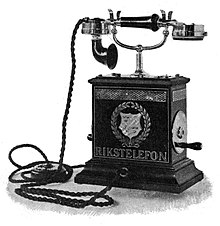Isak Gustaf Clason
Isak Gustaf Clason (born July 30, 1856 in Falun ; † July 19, 1930 ) was a Swedish architect . He was one of the leading architects of the Arts and Crafts Movement in Sweden.
education
Isak Gustaf Clason received his training at the Royal Technical University of Stockholm , where he switched from a purely technical training to the newly established Faculty of Architecture in 1877. He then attended the art academy ( Kungliga Akademien för de fria konsterna ), which he successfully left in 1881 with a royal medal and a travel grant from the state. Subsequent study trips took him to Spain and France .
life and work
A supporter of the Arts and Crafts Movement , Clason was an advocate for the use of "honest" building materials such as granite , brick, and limestone . With the Östermalmshalle from 1888, he and his colleague and partner Kasper Salin introduced the brick architecture of northern Germany to Stockholm. The Bünsowska huset for Friedrich Bünsow on Strandvägen , a building with facades made of German bricks with patterns in black, glazed brick, dates from the same year .
His main work was the Nordic Museum on Djurgården , which was to keep him busy for over twenty years from 1889. This time became the school of the younger employees in Clason's office, including Ragnar Östberg and Lars Israel Wahlman . With the Nordic Museum, Clason returned to a historical formal language that is reminiscent of the northern European Renaissance of the 17th century and of Vadstena Castle .
At the turn of the century in 1900, Clason led the style of Swedish neo-baroque . An example of this is the court house ( Tingshuset ) in Norrköping from 1901. Here Clason worked with plastered, articulated facades, few stone details and a touch of the Swedish great power in the vaults of the stairwell.
In 1905, Clason left the professorship that he had held at the Technical University since 1890 and devoted himself to the construction and restoration of castles and manors, for example the Adelsnäs stud in Östergötland (1912-1922) and Selma Lagerlöfs Mårbacka in Värmland (1925). In 1917 he was made an honorary doctorate in philosophy at Uppsala University.
Isak Gustaf Clason was also one of the country's first industrial designers . In 1894 he designed Sweden's first standard desk phone for the Kongl. Elecktriska Telegraf-Werket .
Other works (selection)
- Thaveniuska huset , Strandvägen in Stockholm, 1884–1885
- Bünsowska huset , Strandvägen in Stockholm, 1886–1888
- Norrlands nation , Uppsala 1889
- Adelswärdska huset , Strömgatan, Stockholm 1889–1890
- Hallwylska palatset , Hamngatan 4, Stockholm 1893–1898
- Norrköpings rådhus , Norrköping 1907-1910
- Villa Mariehill , Djurgården, Stockholm 1908
- Lönö herrgård , Norrköpings kommun, 1911–1913
- Skånska Hypoteksföreningen bankpalats , Lund 1916–1919
- Timmermansordens palats , Stockholm 1913–1923
photos
Web links
swell
- Svensk Arkitektur, Ritningar 1640-1970 , Byggförlaget, 1986. ISBN 91-85194-67-0
| personal data | |
|---|---|
| SURNAME | Clason, Isak Gustaf |
| BRIEF DESCRIPTION | Swedish architect |
| DATE OF BIRTH | July 30, 1856 |
| PLACE OF BIRTH | Falun |
| DATE OF DEATH | July 19, 1930 |







